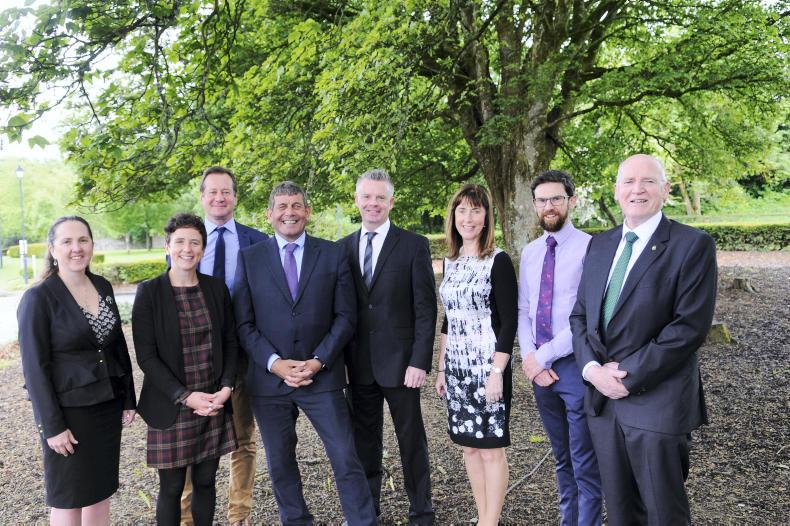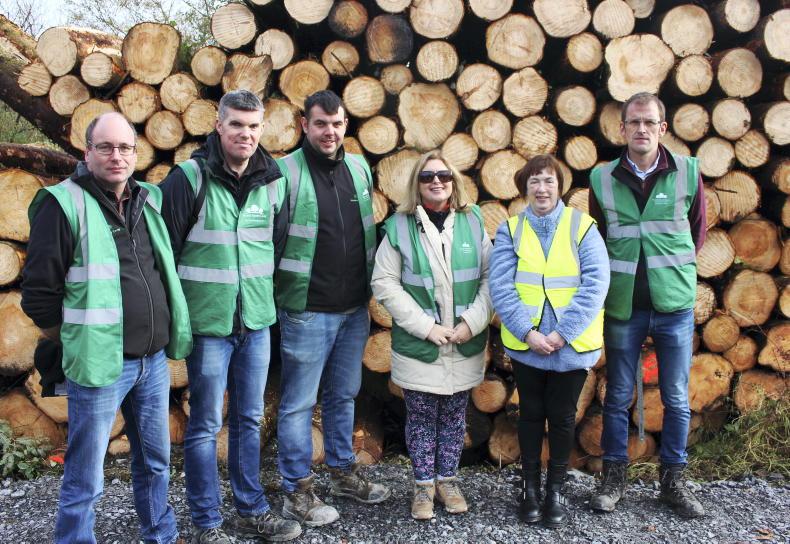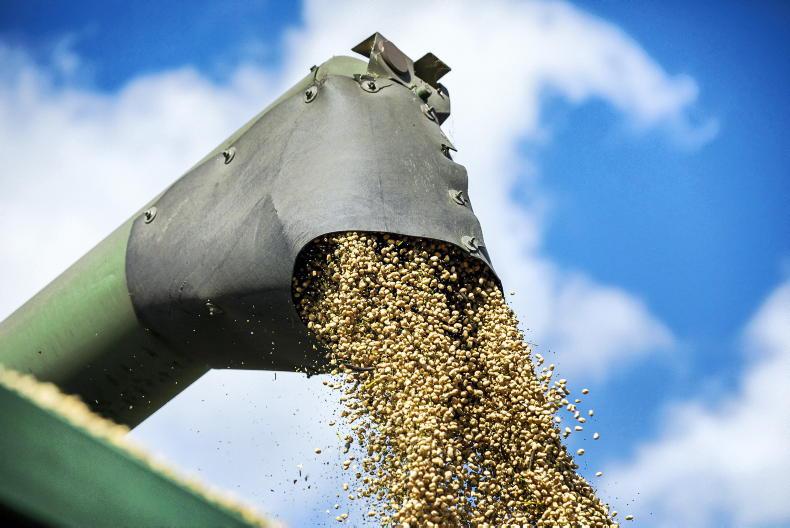Mairi Gougeon, Scotland’s Minister for Rural Affairs and Natural Environment, told delegates at the national forestry conference last week that “there is a growing understanding that forestry and forests are in the front line of our national response to the climate change emergency that faces us all”.
She said: “There is great dynamism in forestry in Scotland at the moment. This is because the Scottish government has made it a priority and has invested in developing and growing the sector.”
In contrast with Ireland, Scotland has 18.5% forest cover and aims to have 21% of the land under forest and woodland by 2032, while the conference was told that Ireland’s target of 18% forest cover won’t be achieved until well into the next century based on current planting levels.
The carbon stored in the forest is one-third of the story
Minister of State Andrew Doyle opened the conference, which explored the central role of forests in climate change mitigation. However, the theme was broadened by speakers including Stuart Goodall, CEO of the UK Confederation of Forest Industries (Confor).
To illustrate this holistic approach, Confor had taken a case study of a mature forest in south Scotland and examined the carbon benefits along the wood chain, from planting to product. “The carbon stored in the forest is one-third of the story,” he said. “More than half as much again is stored in the wood products made from it, but the biggest carbon saving of all is in substitution, whereby timber is used instead of non-renewable masonry, steel, or fossil fuels.”
Halting the loss and degradation of forest ecosystems and promoting their restoration can contribute over one-third of the total climate change mitigation required by 2030 to meet the objectives of the Paris Agreement
In a wide-ranging talk on forestry and climate change, Western Forestry Co-op CEO Marina Conway stressed the need to plant “the right species in the right places”. Quoting Sir David Attenborough, she said that in many instances the right trees were those planted in commercial plantation forests.
She examined the role of forestry from a global and local perspective. “Halting the loss and degradation of forest ecosystems and promoting their restoration can contribute over one-third of the total climate change mitigation required by 2030 to meet the objectives of the Paris Agreement,” she said. She demonstrated how this can be achieved at a national and local level.
Harvested wood products abate close to 1bn tonnes of CO2 but Ireland can improve this further, she told delegates. “Even relatively small operations such as McCauley Wood Fuel in Mohill, Co Leitrim, which takes in 400t of timber weekly, displace 150,000l of heating oil every week. This enterprise is not near full capacity so the benefits for the local economy are enormous as the McCauleys and similar enterprises expand.”
However, in common with other speakers, she said the full potential of forestry will not be realised unless we achieve viable afforestation programmes. This will require a different approach and “may require greater financial incentives” and measures she said, such as:
Linking to agricultural expansion – opportunity of CAP 2020. “Forest performance under the Carbon Navigator is a welcome step but a driver is needed”.A review of forest land such as unenclosed areas and removing pressure from concentrating the afforestation programme in one province.Payment for ecosystem services (PES), in relation to water, carbon and biodiversity. Removal of replanting obligation, which can be done without risking deforestation.Broadleaf afforestation including pioneer birch woodland but 15-year premium period insufficient. This would need payments for ecosystem services.She is a strong advocate of broadleaf planting but acknowledges the major role coniferous production forests will play in decarbonising the economy. High-production plantation forests complement rather than threaten natural woodlands, she explained. In most instances, they provide the only viable source of wood for construction. Quoting Trevor Fenning and Jonathan Gershenzon, she said: “Those who oppose plantation forests, need to be clear what the choices really are, rather than what they might like them to be.”
During the open forum, there was a wide-ranging discussion on issues inhibiting the afforestation programme. The reason for the fall in planting that received most traction was “the elephant in the room” – delays in the issuing of approvals by the Department of Agriculture, Food and the Marine (DAFM) for key elements in the forestry programme. “These delays in receiving approvals for afforestation, felling licences and roading along with cumbersome planning conditions were a major issue,” said Michael Connolly, SWS Forestry. “The system has become extremely burdensome and frustrating for both forestry companies and farmers.”
One farmer who had planted a sizeable portion of his land which is producing an excellent crop is now experiencing unacceptable delays even in receiving a thinning licence
IFA farm forestry chair Vincent Nally said he had attended a meeting the previous evening “where complaint after complaint related to delays in afforestation and felling licence approvals”. To wide applause, he said this issue needs to be addressed urgently as many farmers at the meeting who were “pro-forestry and forest owners” had serious concerns about the direction forestry was taking. “One farmer who had planted a sizeable portion of his land which is producing an excellent crop is now experiencing unacceptable delays even in receiving a thinning licence,” he said. “This farmer who had planned to increase his forest holding has withdrawn his afforestation application.”
The replanting obligation, land availability, land mobility and competing grant measures were cited as reasons for the drop in planting. Gerhard Gallagher said there should be little scientific or environmental barriers to the planting of marginal land that would allow forest cover to increase to 18% of the land area. John McCarthy of None so Hardy Nurseries said a viable afforestation programme can be achieved by a reversing the “20% rule”, which he said “had decimated the afforestation programme”. This ruling, introduced by the DAFM in 2010, limits afforestation of unenclosed land to 20% of the total area planted in any one application.
DAFM officials present did not respond to the points raised during the open forum. Vincent Nally, welcomed the DAFM decision to attend an IFA workshop on 27 June to address the afforestation programme.
Read more
Producing more food means planting more trees
Mairi Gougeon, Scotland’s Minister for Rural Affairs and Natural Environment, told delegates at the national forestry conference last week that “there is a growing understanding that forestry and forests are in the front line of our national response to the climate change emergency that faces us all”.
She said: “There is great dynamism in forestry in Scotland at the moment. This is because the Scottish government has made it a priority and has invested in developing and growing the sector.”
In contrast with Ireland, Scotland has 18.5% forest cover and aims to have 21% of the land under forest and woodland by 2032, while the conference was told that Ireland’s target of 18% forest cover won’t be achieved until well into the next century based on current planting levels.
The carbon stored in the forest is one-third of the story
Minister of State Andrew Doyle opened the conference, which explored the central role of forests in climate change mitigation. However, the theme was broadened by speakers including Stuart Goodall, CEO of the UK Confederation of Forest Industries (Confor).
To illustrate this holistic approach, Confor had taken a case study of a mature forest in south Scotland and examined the carbon benefits along the wood chain, from planting to product. “The carbon stored in the forest is one-third of the story,” he said. “More than half as much again is stored in the wood products made from it, but the biggest carbon saving of all is in substitution, whereby timber is used instead of non-renewable masonry, steel, or fossil fuels.”
Halting the loss and degradation of forest ecosystems and promoting their restoration can contribute over one-third of the total climate change mitigation required by 2030 to meet the objectives of the Paris Agreement
In a wide-ranging talk on forestry and climate change, Western Forestry Co-op CEO Marina Conway stressed the need to plant “the right species in the right places”. Quoting Sir David Attenborough, she said that in many instances the right trees were those planted in commercial plantation forests.
She examined the role of forestry from a global and local perspective. “Halting the loss and degradation of forest ecosystems and promoting their restoration can contribute over one-third of the total climate change mitigation required by 2030 to meet the objectives of the Paris Agreement,” she said. She demonstrated how this can be achieved at a national and local level.
Harvested wood products abate close to 1bn tonnes of CO2 but Ireland can improve this further, she told delegates. “Even relatively small operations such as McCauley Wood Fuel in Mohill, Co Leitrim, which takes in 400t of timber weekly, displace 150,000l of heating oil every week. This enterprise is not near full capacity so the benefits for the local economy are enormous as the McCauleys and similar enterprises expand.”
However, in common with other speakers, she said the full potential of forestry will not be realised unless we achieve viable afforestation programmes. This will require a different approach and “may require greater financial incentives” and measures she said, such as:
Linking to agricultural expansion – opportunity of CAP 2020. “Forest performance under the Carbon Navigator is a welcome step but a driver is needed”.A review of forest land such as unenclosed areas and removing pressure from concentrating the afforestation programme in one province.Payment for ecosystem services (PES), in relation to water, carbon and biodiversity. Removal of replanting obligation, which can be done without risking deforestation.Broadleaf afforestation including pioneer birch woodland but 15-year premium period insufficient. This would need payments for ecosystem services.She is a strong advocate of broadleaf planting but acknowledges the major role coniferous production forests will play in decarbonising the economy. High-production plantation forests complement rather than threaten natural woodlands, she explained. In most instances, they provide the only viable source of wood for construction. Quoting Trevor Fenning and Jonathan Gershenzon, she said: “Those who oppose plantation forests, need to be clear what the choices really are, rather than what they might like them to be.”
During the open forum, there was a wide-ranging discussion on issues inhibiting the afforestation programme. The reason for the fall in planting that received most traction was “the elephant in the room” – delays in the issuing of approvals by the Department of Agriculture, Food and the Marine (DAFM) for key elements in the forestry programme. “These delays in receiving approvals for afforestation, felling licences and roading along with cumbersome planning conditions were a major issue,” said Michael Connolly, SWS Forestry. “The system has become extremely burdensome and frustrating for both forestry companies and farmers.”
One farmer who had planted a sizeable portion of his land which is producing an excellent crop is now experiencing unacceptable delays even in receiving a thinning licence
IFA farm forestry chair Vincent Nally said he had attended a meeting the previous evening “where complaint after complaint related to delays in afforestation and felling licence approvals”. To wide applause, he said this issue needs to be addressed urgently as many farmers at the meeting who were “pro-forestry and forest owners” had serious concerns about the direction forestry was taking. “One farmer who had planted a sizeable portion of his land which is producing an excellent crop is now experiencing unacceptable delays even in receiving a thinning licence,” he said. “This farmer who had planned to increase his forest holding has withdrawn his afforestation application.”
The replanting obligation, land availability, land mobility and competing grant measures were cited as reasons for the drop in planting. Gerhard Gallagher said there should be little scientific or environmental barriers to the planting of marginal land that would allow forest cover to increase to 18% of the land area. John McCarthy of None so Hardy Nurseries said a viable afforestation programme can be achieved by a reversing the “20% rule”, which he said “had decimated the afforestation programme”. This ruling, introduced by the DAFM in 2010, limits afforestation of unenclosed land to 20% of the total area planted in any one application.
DAFM officials present did not respond to the points raised during the open forum. Vincent Nally, welcomed the DAFM decision to attend an IFA workshop on 27 June to address the afforestation programme.
Read more
Producing more food means planting more trees









SHARING OPTIONS